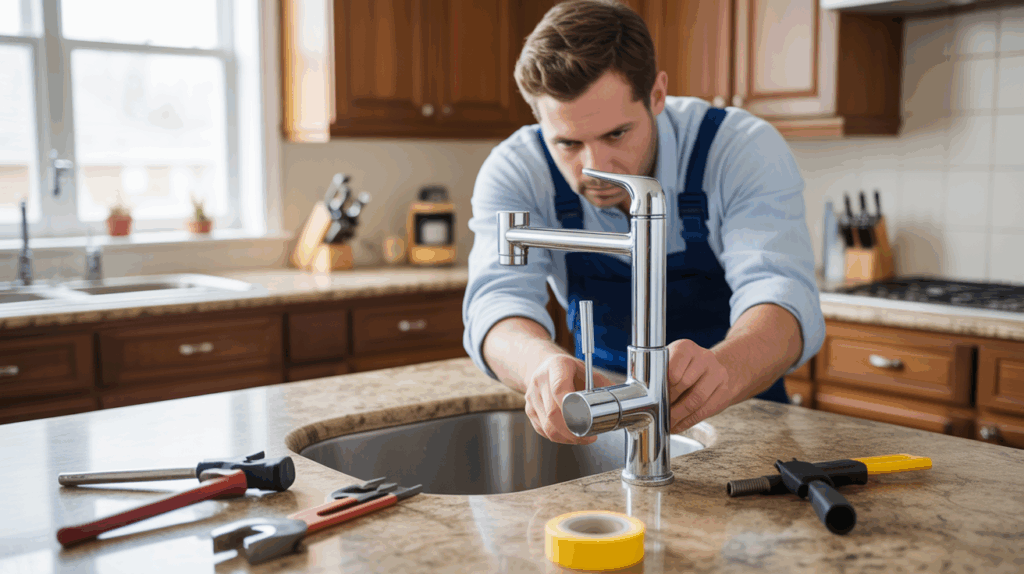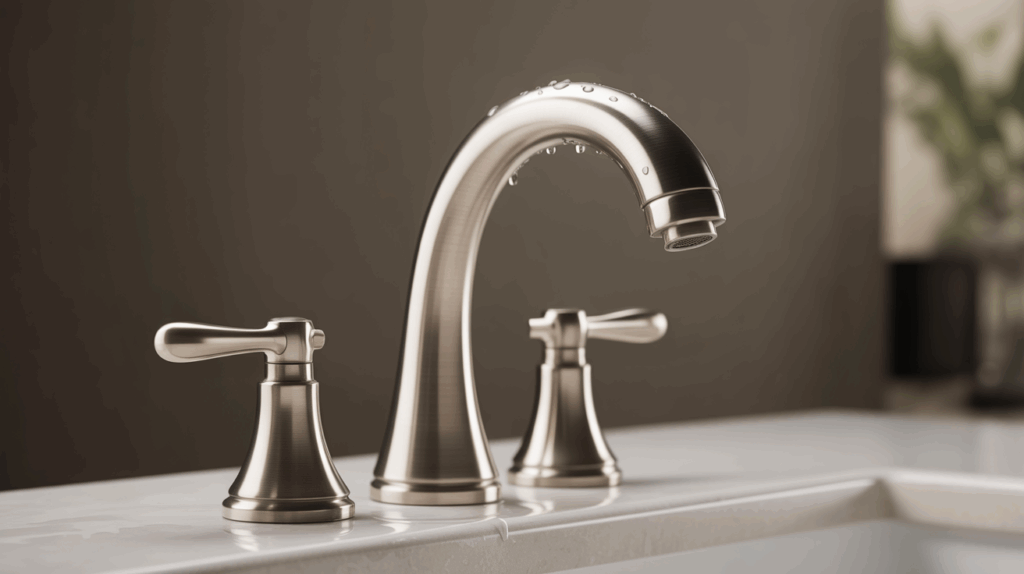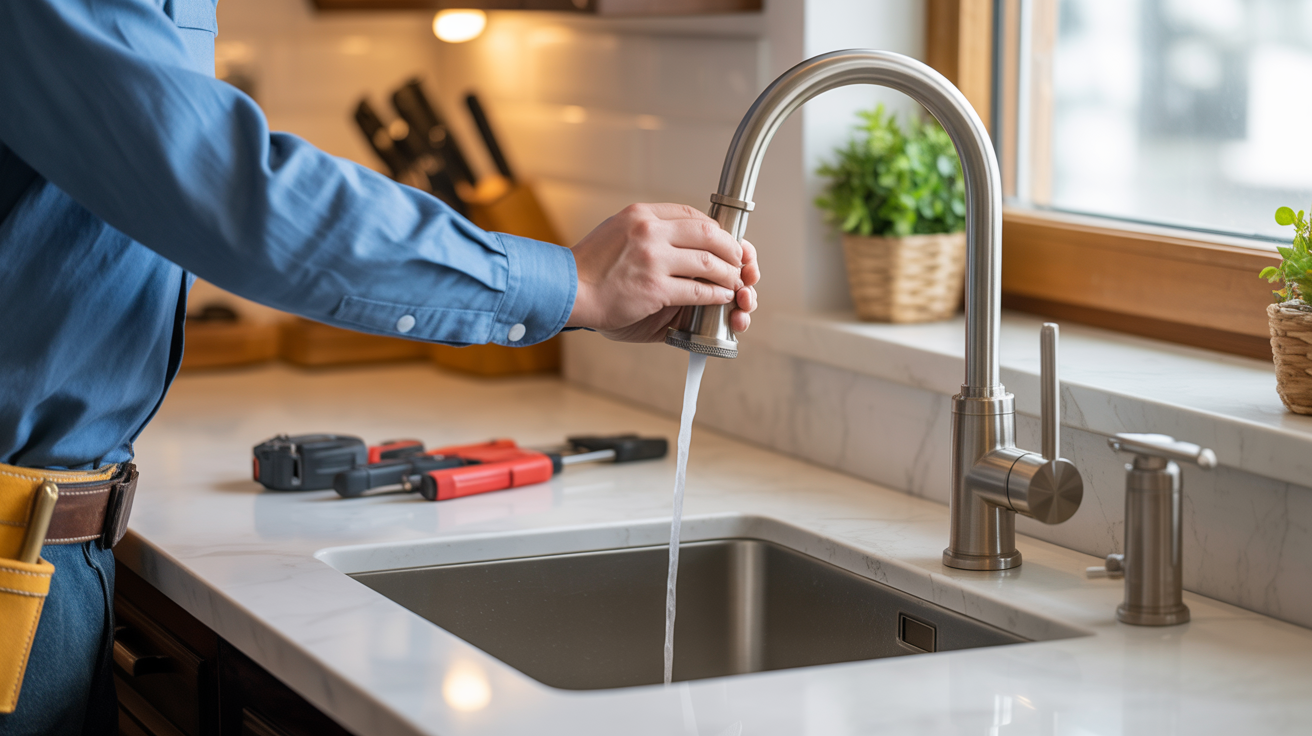Planning to install a new faucet but unsure of the cost? You’re not alone.
I remember staring at a few options, wondering if I could handle it myself or if I’d end up paying way more than expected.
If you’re replacing an old, leaky fixture or giving your kitchen or bathroom a little refresh, understanding the potential costs ahead of time makes the process way less stressful.
I’ve compiled everything I’ve learned from average prices to what people on home forums are paying. You’ll also find a few helpful tips to keep surprise charges from sneaking in.
If you’re trying to budget smart or want to avoid rookie mistakes, this guide is here to help you get it done right, without overpaying.
Let’s get started and make your faucet upgrade smooth, smart, and totally stress-free!
Average Faucet Installation Cost

The typical cost to install a faucet ranges between $150 and $400 for a straightforward job. This usually includes labor, a basic hardware setup, and 1–2 hours of professional time.
If you already own the faucet and there are no plumbing complications, you’re likely to stay on the lower end of that range.
However, if the installation requires removing an old faucet, modifying pipe connections, or installing a wall-mounted model, the cost can increase to $500–$750 or more.
In luxury or high-end cases, such as custom fixtures or setups requiring new plumbing lines, you could be looking at close to $1,000. Homes in urban areas with higher labor costs may also drive prices up.
If you plan to DIY, your savings on labor may be offset by the cost of tools, materials, and time. Still, it can be worth it if you’re confident in your skills.
| Installation Scenario | Estimated Cost |
|---|---|
| Basic Faucet Install | $150 – $250 |
| Moderate Install | $250 – $400 |
| Advanced Setup | $500 – $750 |
| High-End or Custom | $750 – $1,000+ |
| DIY (tools + faucet) | $70 – $250 |
This table will help you quickly see where your installation might fall, based on complexity. If you’re unsure, getting a couple of local quotes can give you a clearer picture.
Factors that Affect Faucet Installation Cost
Several factors influence how much you’ll pay for faucet installation, and understanding them can help you plan realistically and avoid surprise charges.
1. Type of Faucet
The design and complexity of your faucet impact installation cost. Standard models like single-handle or basic two-handle faucets are easier and cheaper to install, usually around $150–$250 including labor.
More advanced models like touchless, pull-down, or wall-mounted faucets can raise the cost to $300–$500 or more due to electrical components or extra plumbing adjustments.
2. Location of Installation
Installing a faucet in an existing kitchen or bathroom sink is generally less expensive, averaging $150–$250. However, installing one in a new area like a laundry room or outdoor sink can cost $300–$600 or more.
That’s because new plumbing lines may need to be added or rerouted, and sometimes additional wall or countertop work is required.
3. Condition of Existing Plumbing
If your existing pipes, valves, or fittings are worn out, corroded, or leaking, repairs will be needed before installation.
These repairs can increase total costs by $50–$200, depending on the extent of the issue. If everything is in good shape and lines align properly, the installation stays closer to the base price of $150–$200.
4. Labor Rates in Your Area
Labor costs vary significantly based on location. In urban areas or high-cost regions, licensed plumbers often charge $75–$150 per hour.
In rural areas or small towns, rates can be as low as $50–$80 per hour. Always check local rates and ask for quotes, especially for jobs that take more than a basic hour of labor.
5. Additional Parts and Materials
If your faucet doesn’t come with all the needed hardware (supply lines, washers, valves, etc.), you’ll need to buy them separately.
Expect to pay an extra $20–$50 for standard parts. If specialized connectors or extension hoses are required, costs can rise to $75–$100. These add-ons may seem minor, but they quickly raise your final bill.
DIY vs. Hiring a Plumber
Learn the pros and cons of installing a faucet yourself versus hiring a pro and decide which option fits your budget, skill level, and timeline for a smooth, stress-free upgrade.
| Aspect | DIY | Hiring a Plumber |
|---|---|---|
| Cost | Lower upfront (tools + time only) | Higher upfront ($150–$400+ for labor) |
| Skill Level Needed | Moderate to high, depending on faucet type | None, you rely on the pro’s expertise |
| Time Commitment | 1–3 hours for most installs | 1–2 hours (quick and efficient) |
| Tools Required | Must be purchased or borrowed | The plumber brings everything |
| Risk of Issues | Higher if unfamiliar with plumbing | Lower, licensed plumbers reduce the chance of leaks |
| Peace of Mind | Depends on your confidence and past experience | Higher, includes guarantees or warranties |
Kitchen vs. Bathroom Faucet Cost Differences

Kitchen faucets usually cost more to install than bathroom faucets, and for good reason.
Kitchen models are often larger, with added features like pull-down sprayers, touch sensors, or multiple spray settings. These extras add complexity to the installation process.
Kitchens may also include accessories like integrated soap dispensers or water filtration systems, requiring additional drilling or connections.
Plus, the plumbing and sink layout under a kitchen counter is often harder to access, which adds to labor time.
In contrast, bathroom faucets tend to be smaller and simpler. Most have basic connections and fewer built-in extras, making installation faster and easier.
- Kitchen faucet installation: $200–$500
- Bathroom faucet installation: $150–$350
These ranges can vary based on your location, faucet style, and plumbing condition, but they’re a solid starting point for budgeting.
Hidden Costs You Might Overlook
Unexpected fees can sneak into your faucet installation budget. This section highlights common extras like disposal, repairs, or emergency service charges so you can plan ahead with confidence.
1. Old faucet removal: Some plumbers charge an extra $20–$50 to remove and dispose of the old faucet, especially if it’s rusted or requires extra effort to take out.
2. New supply lines or valves: Outdated or corroded supply lines or shut-off valves often need replacing, which can add $10–$50 to your total cost, depending on materials and labor time.
3. Additional repairs: If your cabinet base has water damage or your valves are leaking, the plumber may need extra time and materials, which could raise the overall installation cost.
4. Weekend or emergency service fees: Calling a plumber outside of standard business hours, like weekends or evenings, can lead to a 10–30% fee increase for urgent or after-hours service.
When to Replace vs. Repair a Faucet
Not every faucet problem means it’s time for a full replacement. In many cases, a quick and inexpensive fix can restore function, saving you time, money, and hassle.
But knowing when to repair and when to replace can make all the difference in long-term cost and convenience.
| Situation | Repair or Replace? | Details |
|---|---|---|
| Slow drip or minor leak | Repair | Usually fixed with a $10–$20 kit (washer, O-ring, or cartridge). |
| The faucet is under 10 years old | Repair | Most parts are still available, and performance is usually still solid. |
| Multiple leaks (spout, handle, base) | Replace | Internal wear and tear is likely beyond simple fixes. |
| Rust or corrosion is visible | Replace | Corrosion weakens the faucet and may affect water quality. |
| Outdated style or finish | Replace | Consider a new model to match your updated space or decor. |
| Loose handle or aerator blockage | Repair | Easy fixes with small replacement parts or cleaning. |
| Faucet over 10–15 years old | Replace | Performance usually declines, and replacement is more cost-effective long-term. |
Online Faucet Installation Cost Calculators
You don’t have to guess your installation costs. These handy online tools help you estimate based on your location, faucet type, and labor needs. Below are three popular and easy-to-use options:
1. HomeAdvisor’s Faucet Installation Calculator
HomeAdvisor’s calculator asks for your ZIP code and project details to generate a tailored cost range. It also compares your estimate to national and regional averages, helping you understand where your quote fits.
The tool is ideal if you’re comparing prices before hiring a pro or budgeting your project.
2. Fixr’s Cost Guide for Plumbing Projects
Fixr offers a detailed plumbing cost guide that breaks down faucet installation pricing by complexity and region. You’ll find visuals, descriptions, and national averages that help you estimate labor, materials, and extras.
It’s perfect for users who want context along with their numbers.
3. Lowe’s or Home Depot Estimator Tools
These home improvement giants provide project estimators online. Enter faucet type, installation needs, and ZIP code to get a general price range.
These tools are especially helpful if you’re also buying your faucet from them or considering their installation services.
4. Angi Faucet Installation Estimator
Angi’s tool connects you with local professionals and offers estimated pricing based on similar projects in your area. It’s a great resource if you’re ready to move from planning to hiring.
After entering a few details about your job, it gives you a cost range and the option to compare quotes from vetted pros.
Tips to Save on Installation
Everyone wants to cut costs without cutting corners. Let’s see some practical tips I’ve learned:
- Buy your faucet separately: Many homeowners report that buying the fixture yourself online or at a warehouse store is cheaper than getting it through a contractor.
- Bundle plumbing jobs: If you’re replacing a toilet or adding a new sink, schedule everything at once. You’ll often get a better rate per item.
- Do the prep work: Clear the cabinet, remove the old faucet if you’re confident, and have all parts ready for the installer.
- Use handyman services for basic swaps: For simple jobs, a licensed handyman may be more affordable than a master plumber.
Conclusion
Wrapping up, installing a new faucet doesn’t have to feel overwhelming, especially when you know what to expect. I’ve been there, trying to figure out if I should fix a drip or just go for a fresh install.
With the right info, you can confidently decide what works best for your home and budget.
If you’re going the DIY route or calling in a pro, understanding the cost breakdown, hidden fees, and smart tips can save you stress and money.
If you’ve got questions or want to share your own experience, feel free to drop a comment. I’d love to hear how your project goes!
Ready to get started? Pick your faucet, and take the next step toward a smoother, leak-free upgrade.

